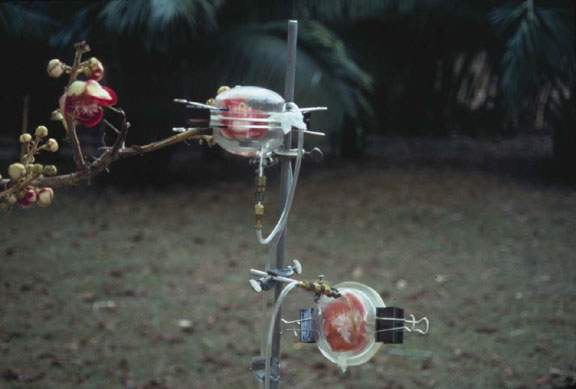
In the perfume industry there is a lot of emphasis on things being natural and people tend to be sceptical of fragrances that aren’t literal in their representation of nature. There’s a thirst for realism and more often than not, people want ‘real’ flowers in their juice, rather than ‘synthetic’ ones. Natural doesn’t always mean better though and it’s a known fact that the use of synthetic ingredients or isolated materials has allowed the industry to move forward in leaps and bounds (it’s also a fact that synthetics are generally more stable and long-lasting than many naturals). Without a mixture of the two, perfumes often feel flat and two-dimensional. Chemophobia may be the moral high ground (or complete, utter craziness, if you ask me), but it’s the embracing of new materials and technologies that allows for true innovation and artistry in the world of fragrance.
One of the most fascinating examples of innovation in perfume is Headspace technology. Developed in the 1980s, Headspace acts as a fragrant camera that captures and decodes the molecules in the air surrounding a particular material or object, providing a perfumer with raw data they can use to piece together a familiar smell using other notes and ingredients. Without Headspace, our perfumes would be devoid of such wonderful things as lily-of-the-valley, caviar and nail polish. It’s an important tool that allows perfumes to truly represent the world around us, and in some instances, an imagined world that is greater than our own.

I’m not going to get too scientific or tech-y here, simply because the levels of science my brain can handle are desperately low, and I’m not going to pretend that I know stuff that I don’t. So here’s a quote from Wikipedia that highlights, in layman’s terms, the basics of Headspace technology:
“The headspace equipment involves a hollow dome or sphere-like objects which forms an airtight seal and surrounds the objects of interest. Inert gases are passed into the space containing the object or a vacuum is established such that the odor compounds are removed from the headspace. These compounds are in turn captured using a variety of techniques among them cold surfaces, solvent traps, and adsorbent materials, with the latter techniques capable of longer periods of collection. The samples can then be analyzed using techniques such as gas chromatography, mass spectrometry, or Carbon-13 NMR”
– Wikipedia ¹
Each of the big fragrance manufacturers have their own patented versions of Headspace. Taksago has Aromascope™, Mane has Jungle Essence™, Firmenich has NaturePrint™ and Givaudan has ScentTrek™. This goes to show just how essential Headspace is. The technology allows a perfumer to take an olfactory snapshot of something in nature that isn’t extractable via traditional methods, or if it is able to be extracted, the end result varies significantly from the smell of the real thing. Take rose for example, the oil of which smells completely different from the odour of fresh, ripe rose buds on the stem. So, first and foremost it is a vital tool to allow perfumers to analyse and recreate something that they otherwise wouldn’t be able to utilise as a fragrance material.
Vitally, Headspace extends the perfumers pallet. It unlocks nature’s secret garden and provides them with odours that would otherwise be off limits. Headspace also allows perfume creators to be more unconventional with their materials by grabbing things from nature that are unheard of in the world of perfume. Want to capture the mineral-filled smell of rain-soaked cobbles? Headspace can do that. Desperate to recreate the pungent odour of gardenia, or the heavenly sense of hot dust off a lightbulb? Headspace is your guy.
Perhaps one of the most notable uses of Headspace in fragrance is Comme des Garçons’ anti-perfume ‘Odeur 53‘. Boasting notes of; Freshness of Oxygen, Flash of Metal, Fire Energy, Washing drying in the wind, Mineral intensity of carbon, Sand Dunes, Nail Polish, Cellulosic smell, Pure air of the high mountains, Ultimate Fusion, Burnt Rubber and Flaming Rock, Odeur 53 is an exercise in abstraction that captures familiar smells and turns them into something entirely unfamiliar, proving that there is more to perfume than ‘natural’ ingredients. Of course, many of these notes refer to impressions or inflections caused by the mix of ingredients within the fragrance and aren’t intended as a real list of captured essences, but it is exciting to think that ‘burnt rubber’ is a smell one could analyse and recreate in a perfume.
Most remarkably, the technology has been used to capture the smell of, not only individual materials, but also places too, such as “tea shops, classrooms and saw mills” ². The possibilities with the technology are certainly exciting. I for one, can think of a dozen or so places that I’d like to ‘capture’ in scent form. The smell of the dusty timber frames in my childhood home, the odd play-doh aroma of just about every village hall I’ve ever been in and the starchy smell of the Tokyo metro, just to name a few. Fragrance has always acted as a time capsule for memory and Headspace technology is a key component in that time machine, its Flux Capacitor, if you will.

“The pioneering use of NaturePrint™ technology has enabled us to capture the scent of Omani incense without harming the Boswellia sacra or its environment. Resinous incense tears are taken to the fragrance house to create an infusion and essential oil. These are then analysed in the laboratory in order to recreate the scent using natural ingredients, directed by a Master Perfumer.”
– Jo Malone, London ³
I was recently at a launch event for Jo Malone’s latest Cologne Intense, ‘Incense & Cedrat‘ (more on that particular fragrance in a few weeks) and was struck by perfumer Marie Salamagne’s comments on NaturePrint™ (Firmenich’s Headspace tech). With Incense & Cedrat, the prime purpose for the use of Headspace was purely for ecological reasons. Over-harvesting of natural materials can cause problems for perfume houses, due to the varying prices and availability of ingredients, but also for the local communities that depend so highly on the success of important perfume crops. It is therefore reassuring to see brands utilising such technology to behave responsibly and in an environmentally friendly manner. It’s not all about capturing elusive odours, it’s about the environment too.
Given cart blanche, I think we’d all present a veritable shopping list of odours we’d like to capture. Perhaps not for the purpose of perfume per se, but more as fragrant reminders to comfort, transport and beguile. Below is a non-exhaustive list of things I would like to capture via Headspace, if I could. Not all are feasible and some may smell unpleasant out of context or in isolation, but they are a selection of some of my favourite odours none the less.
New clothes
The top of my cat’s head
New car
Petroleum
Burned matches
My husband’s cheek when we kiss
Old books
New books (with glossy pages)
Plastic pencil cases
The hectic, incense filled air at Senso-Ji Temple, Tokyo
Join the Discussion
What would you like to capture via Headspace?
What are your favourite examples of Headspace either, as ingredients or in perfumes?
Disclaimer
Image 1 via cafleurbon.com. Image 2 via nybg.org. Image 3 is my own. ¹ via Wikipedia. ² via curiositychronicles.tumblr.com. ³ via Jo Malone Incense & Cedrat Press Release.

